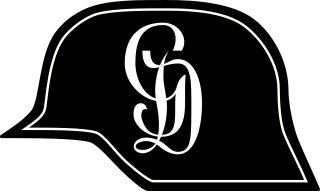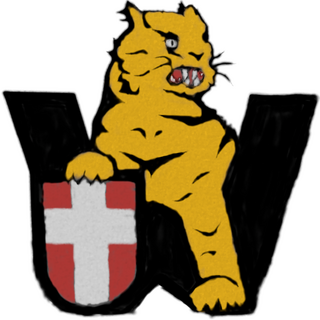
The Panzergrenadier Division "Großdeutschland", also commonly referred to simply as Großdeutschland or Großdeutschland Division, was an elite combat unit of the German Army that fought on the Eastern Front in World War II.

The 1st SS Panzer Division Leibstandarte SS Adolf Hitler or SS Division Leibstandarte, abbreviated as LSSAH, began as Adolf Hitler's personal bodyguard unit, responsible for guarding the Führer's person, offices, and residences. Initially the size of a regiment, the LSSAH eventually grew into an elite division-sized unit during World War II.
101st Heavy SS Panzer Battalion was a German heavy tank battalion in the Waffen-SS during World War II. With the introduction of new Tiger II tanks in late 1944, the unit was renumbered as the 501st Heavy SS Panzer Battalion.

The 5th SS Panzer Division Wiking or SS Division Wiking was an infantry and later an armoured division among the thirty-eight Waffen-SS divisions of Nazi Germany. During World War II, the division served on the Eastern Front. It surrendered on 9 May 1945 to the American forces in Austria.

The 9th Panzer Division was a panzer division of the German Army during World War II. It came into existence after 4th Light Division was reorganized in January 1940. The division was headquartered in Vienna, in the German military district Wehrkreis XVII.

III Army Corps was a corps level formation of the German Army during World War II.

The 9th SS Panzer Division "Hohenstaufen" was a Waffen-SS armoured division of Nazi Germany during World War II. It participated in battles on both the Eastern and Western Fronts. The division was activated in December 1942. Many of the men of the division were young German conscripts, with a cadre of NCOs and staff from the SS Division Leibstandarte and other Waffen SS divisions. Hohenstaufen took part in the relief of German forces in the Kamenets-Podolsky pocket, the Normandy battles, Operation Market Garden, the Ardennes Offensive and Operation Spring Awakening. The division surrendered to the United States Army on 8 May 1945, at Steyr.

The Lvov–Sandomierz offensive or Lvov–Sandomierz strategic offensive operation was a major Red Army operation to force the German troops from Ukraine and Eastern Poland. Launched in mid-July 1944, the operation was successfully completed by the end of August.
The IV SS Panzer Corps was a panzer corps of the Waffen-SS which saw action on the Eastern Front and in the Balkans during World War II.
The II SS Panzer Corps was a German Waffen-SS armoured corps which saw action on both the Eastern and Western Fronts during World War II. It was commanded by Paul Hausser during the Third Battle of Kharkov and the Battle of Kursk in 1943 and by Wilhelm Bittrich on the Western Front in 1944.
The IX Waffen Mountain Corps of the SS (Croatian) (German: IX. Waffen-Gebirgskorps der SS (Kroatisches)), later simply IX SS Mountain Corps, was a Waffen-SS corps during World War II. Originally set up to command Croatian and Albanian SS divisions, it also commanded a variety of other German and Hungarian units of the Waffen-SS. It saw action on the Eastern Front between July 1944 and January 1945 when it was virtually destroyed during the Siege of Budapest.

The I SS Panzer Corps was a German armoured corps of the Waffen-SS. It saw action on both the Western and Eastern Fronts during World War II.
The 503rd Heavy Panzer Battalion was a German heavy Panzer Abteilung equipped with Tiger I and Panzer III tanks. In 1944, it was re-equipped with the new Tiger II. The battalion saw action on the Eastern and Western Fronts during World War II. As with other German heavy tank battalions, it was normally not assigned to a single corps, but shuffled around according to war circumstances. Later the battalion became part of the newly formed Panzer Corps Feldherrnhalle as the Feldherrnhalle Heavy Tank Battalion.

A German heavy tank battalion was a battalion-sized World War II tank unit of the German Army (1935–1945), equipped with Tiger I, and later Tiger II, heavy tanks. Originally intended to fight on the offensive during breakthrough operations, the German late-war realities required it to be used in a defensive posture by providing heavy fire support and counter-attacking enemy armored breakthroughs, often organised into ad hoc Kampfgruppen.

The 17th Panzer Division was a formation of the Wehrmacht in World War II. It was formed in November 1940 from the 27th Infantry Division. It took part in Operation Barbarossa, the invasion of the Soviet Union in June 1941, and in the winter of 1941–42 participated in the Battle of Moscow. In November 1942, the division was sent to the southern sector of the Eastern Front where it participated in Operation Winter Storm, the failed attempt to relieve the surrounded troops at Stalingrad. The division was held in reserve during the Battle of Kursk in 1943, and thereafter retreated through Ukraine and Poland, before ending the war in Czechoslovakia.

The 25th Panzer Division was a tank formation of the German Army during World War II. It was one of several understrength Panzer divisions formed during the last years of the war.

The 502nd Heavy Panzer Battalion was a German heavy tank battalion during World War II. The battalion was the first unit to receive and field the Tiger I. It fought on the Eastern front. It was one of the most successful German heavy tank battalions, claiming the destruction of 1,400 tanks and 2,000 guns. Otto Carius, one of the best German tank aces, was a member.
The 501st Heavy Panzer Battalion was a German heavy Panzer Abteilung equipped with heavy tanks. The battalion was the second unit to receive and use the Tiger I heavy tank, changing to Tiger IIs in mid-1944.
The 102nd Heavy SS Panzer Battalion was a German heavy tank battalion of the Waffen-SS during World War II. It fought as part of the II SS Panzer Corps during the Battle of Normandy and was nearly destroyed. Renumbered as 502nd Heavy SS Panzer Battalion in late 1944, the unit was destroyed in the Halbe Pocket in Spring 1945.

The 506th Heavy Panzer Battalion was a german heavy Panzer Abteilung equipped with Tiger I tanks until 28 July 1944. During the period from 20 August to 12 September 1944, it was re-equipped with a full complement of 45 Tiger Ausf. B tanks. Some of the first Tiger IIs delivered to the 506th were examples fitted with the early production turret. The battalion saw action on the Eastern and Western Fronts during World War II. As with other German heavy tank battalions, it was attached as needed to larger formations. The 506th was unique in being the only Tiger battalion to include a fourth company. German: schwere Panzerkompanie Hummel, equipped with Tiger I tanks, was consolidated with the 506th in 1944. It was also unique in that it regularly received new vehicles and replacements from other units to maintain a full complement. The unit served until the collapse of the Ruhr Pocket in April 1945, being officially disbanded by the battalion commander on 14 April. The unit performed well despite often poor conditions of deployment, officially credited with over 400 tank kills during its service with fewer than 75 combat losses.












